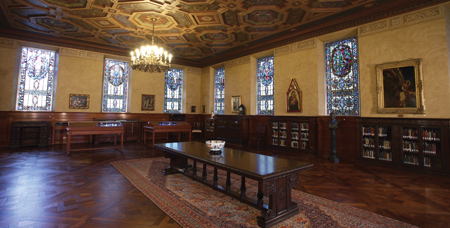Celebratons honoring the bi-centennial of Robert Browning’s birth are taking place on each side of the Atlantic. In late June, a conference sponsored by the Browning Society of London focused on a particular aspect of Browning’s work–the dramatic monologue. For those who are unfamiliar with the term, the following definition is offered.
M. H. Abrams, one of the general editors of the Norton Anthology of English Literature and a respected American critic known especially for work on Romanticism, lists three features of the dramatic monologue as it applies to poetry:
1. A single person, who is clearly not the poet, utters the speech that makes up the whole of the poem, in a specific situation at a critical moment.
2. This person addresses and interacts with one or more people; but we know of the auditors’ presence, and what they say or do, only from clues in the discourse of the single speaker.
3. The main principle controlling the poet’s choice and formulation of what the lyric speaker says is to reveal to the reader, in a way that enhances its interest, the speaker’s temperament and chararcter
Robert Browning is considered to be the perfecter of the dramatic monologue, which had its heyday in the Victorian Period. Other Victorian poets to produce one or more dramatic monologues include Alfred Lord Tennyson, Elizabeth Barrett Browning, Matthew Arnold, Dante Gabriel Rossetti, Christina Rossetti, and Algernon Charles Swinburne. None, however, produced as many, or as striking, dramatic monologues as Robert Browning. A famous example is Browning’s “My Last Duchess.” Notice how the Duke’s character is revealed by what he says:
“MY LAST DUCHESS”
That’s my last Duchess painted on the wall,
Looking as if she were alive. I call
That piece a wonder, now: Fra Pandolf’s hands
Worked busily a day, and there she stands.
Will’t please you sit and look at her? I said
“Fra Pandolf” by design, for never read
Strangers like you that pictured countenance,
The depth and passion of its earnest glance,
But to myself they turned (since none puts by
The curtain I have drawn for you, but I)
And seemed as they would ask me, if they durst,
How such a glance came there; so, not the first
Are you to turn and ask thus. Sir, ’twas not
Her husband’s presence only, called that spot
Of joy into the Duchess’ cheek: perhaps
Fra Pandolf chanced to say “Her mantle laps
Over my lady’s wrist too much,” or “Paint
Must never hope to reproduce the faint
Half-flush that dies along her throat”: such stuff
Was courtesy, she thought, and cause enough
For calling up that spot of joy. She had
A heart—how shall I say?—too soon made glad,
Too easily impressed; she liked whate’er
She looked on, and her looks went everywhere.
Sir, ’twas all one! My favour at her breast,
The dropping of the daylight in the West,
The bough of cherries some officious fool
Broke in the orchard for her, the white mule
She rode with round the terrace—all and each
Would draw from her alike the approving speech,
Or blush, at least. She thanked men,—good! but thanked
Somehow—I know not how—as if she ranked
My gift of a nine-hundred-years-old name
With anybody’s gift. Who’d stoop to blame
This sort of trifling? Even had you skill
In speech—(which I have not)—to make your will
Quite clear to such an one, and say, “Just this
Or that in you disgusts me; here you miss,
Or there exceed the mark”—and if she let
Herself be lessoned so, nor plainly set
Her wits to yours, forsooth, and made excuse,
—E’en then would be some stooping; and I choose
Never to stoop. Oh sir, she smiled, no doubt,
Whene’er I passed her; but who passed without
Much the same smile? This grew; I gave commands;
Then all smiles stopped together. There she stands
As if alive. Will’t please you rise? We’ll meet
The company below, then. I repeat,
The Count your master’s known munificence
Is ample warrant that no just pretence
Of mine for dowry will be disallowed;
Though his fair daughter’s self, as I avowed
At starting, is my object. Nay, we’ll go
Together down, sir. Notice Neptune, though,
Taming a sea-horse, thought a rarity,
Other of Browning’s brief dramatic monologues include “Soliloquy of the Spanish Cloister,” “The Laboratory” and “Porphyria’s Lover.” Several important longer dramatic monologues, which appeared in the poet’s collection Men and Women are “Fra Lippo Lippi,” “Bishop Blougram’s Apology,” and “Andrea del Sarto.” His crowning achievement in the style are the dramatic monologues he wrote for his acknowledged masterwork The Ring and the Book, published in four installments in 1868-1869.
The Ring and the Book, an epic-length poem of 21,000 lines, is based on the documents from a Roman murder trial of 1698. From this material Browning created a verse-novel that includes twelve “Books,” ten of which are dramatic monologues offering the differing perspectives of narrators involved in the case. The one accused of murder, an impoverished nobleman named Count Guido Franceschini, speaks twice. The first and twelfth books are spoken by the poet himself. The Ring and the Book has been called a tour de force of dramatic poetry and was a great success both commercially and critically.




